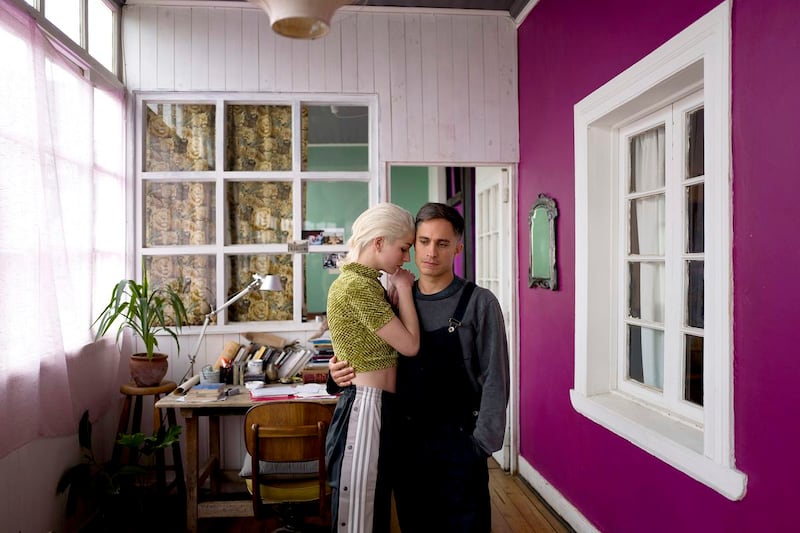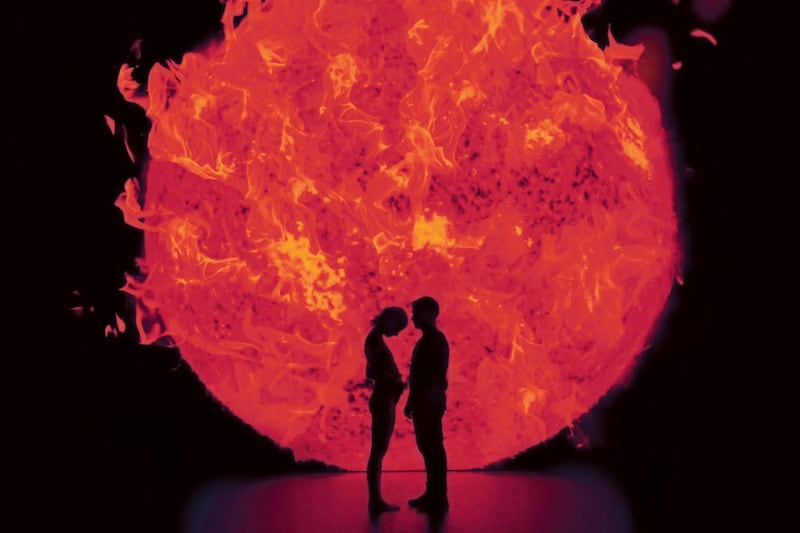Nobody expects cosy cinema from Pablo Larraín, the Chilean provocateur who has built dramas around a murderous, excrement-smearing John Travolta impersonator (Tony Manero), a house of paedophile priests (The Club), and a drunken, widowed First Lady (Jackie).
Ema is the director’s most daring – and brilliant – film yet. The title character – strap in – is a pyromaniac dancer (played with mighty sass by Chilean soap opera star, Mariana Di Girolamo) who continues to work with her estranged choreographer husband Gastón (Gael García Bernal), even though they verbally tear strips off one another. Insults are repeatedly hurled right into the lens of Sergio Armstrong’s camera. Ema is a monster; Gastón is infertile. And so on.
It’s complicated. Each blames the other for dumping their adoptive son Polo back at the orphanage after he became a handful, what with his burning down the house, scarring his aunt’s face and shutting the dog inside the freezer.
Ema responds to her loss by building a life away from Gastón, a life featuring many new sexual partners and reggaeton. If Gaspar Noé’s Climax was dance meets horror, then Ema is dance meets a sexy telenovela. It’s a wild, electrifying piece of cinema, made all the more unpredictable by the lack of a conventional script.
“It felt like a mystery,” says García Bernal, speaking via Zoom from Mexico. “Okay, all films are mysteries; you don’t know how they’re going end up . . . but this one had mystery as its kind of guiding mantra. We didn’t know the scenes from day to day. We only knew them the night before or right on the day. We just went for the journey the Pablo had described to us and that was also changing a lot. I didn’t know what to expect. We did not know what nationality my character was going to be so right at the beginning. We thought he might be from different parts of the world so he speaks in a different or weird accent. I tried it for one day and then Pablo told me: Oh man, let’s just make him Mexican.
"That’s the poetic journey Pablo takes you on. There’s a lot of experimentation. There was a sense of the actors appropriated his words as we couldn’t learn the whole monologues. So we had to play around. I started to say things in my rant that I think somebody that hates reggaeton would say. Then but then I started to put in things that I completely agree with. I was thinking of the sacrifice these artists make in their lives. You want to sell out? Okay, let’s quit, let’s quit life, let’s go to Ibiza and have copy coffee or go to Malay and take selfies. It’s weird listening to that now in this worldwide confinement.”

Ema opens with a shot of punkish peroxide heroine walking down the early morning streets of Valparaíso with a flamethrower strapped to her back. Throughout the film, starting fires, dance and sex all work in literal and figurative ways to challenge conventional notions of romantic love and family. The men, says García Bernal, as merely there to play witness.
“The film shows a new family, a new concept of a family,” says the actor. “Pablo was very good at pointing this out. Life reinvents itself constantly. But we still think in medieval concepts. The model of the family that we talk about – the nuclear family – is very western. In other cultures the family has been different throughout history.
“So Ema was a way of bringing things to the table that are being talked about a lot right now, especially in Latin America where the women’s movement is tackling issues that really matter in our societies. But it also looks at the relationship between men and women and the way each gender uses their gender to hurt or dominate the other person and how that evolves. I mean, all couples are weird. The world that a couple builds is very weird. When you look at it from the outside it looks, I don’t know, almost silly. But inside it looks like normality.”
Ema is García Bernal’s third film with Pablo Larraín. The actor says he’s always waiting for a phone call from the director. Their previous features include 2012’s No, a dramatisation of the 1988 plebiscite, in which the Chilean people voted on whether dictator Augusto Pinochet should stay in power for another eight years; and 2016’s Neruda, which cast García Bernal as the poet’s prime persecutor, the chief of the Investigations Police of Chile Oscar Peluchonneau.
These collaborations are in keeping with García Bernal’s reputation as Mexico’s “most political actor”. To that end, he has played Che twice; starred as the Iranian-Canadian journalist Maziar Bahari in Jon Stewart’s directorial debut, Rosewater; and stood against deforesters in the eco-drama The Burning.
He has long been an activist. Aged 14, he taught indigenous people in Mexico to read. Aged 15, he took part in the Chiapas uprising of 1994. He has produced a biopic of American labour organiser Cesar Chavez, TV documentaries on the unsolved murders of more than 300 women in the border city of Ciudad Juarez, and a series of films with Amnesty International, detailing the dangers faced by Central American migrants. In Who Is Dayani Cristal?, he traces the footsteps of a man who died in a desert trying to cross into the United States; in Werner Herzog’s Salt and Fire, he plays a kidnapped environmental scientist.
The most literal and the most evident part of my work are the political films. I'm excited by films that have a political complexity
Against this, there’s an insatiable curiosity about art in his work. For his Golden Globe winning turn in Amazon Prime’s Mozart of the Jungle, he had to conduct the LA Philharmonic Orchestra. His turn in Ema – in common with his contributions to José and Pilar, a documentary portrait of Nobel Prize winner José Saramago, and the comic book sci-fi Zoom – is the latest performance that probes the nature of the artist.
“Does that interest me objectively? Yes, it does,” he mulls. “Do I search for it? Maybe I do. The most literal and the most evident part of my work are the political films. I’m excited by films that have a political complexity. Whenever I try to look for a connection with the other films, it turns into a kind of psychoanalytic questioning. It’ll be interesting one day looking back one day and trying to work out the unknown mechanisms.”
Born to Patricia Bernal, an actor and a model, and, José Ángel García, an actor and director, and raised by his mother and stepfather (the cinematographer Sergio Yazbek), Gael García Bernal made his screen debut when he was still a baby. Aged 10, he was cast in Teresa, a telenovela starring Salma Hayek as a beautiful, money-obsessed young woman.
“I grew up feeling that Salma was already a huge star,” he says. “That’s how it was for me. She has always been a person who if she if she walked into a room, everyone would vote for her for president.”
After Y Tu Mamá También introduced García Bernal to worldwide audiences, he was inundated with scripts from Hollywood. He is not entirely adverse to Anglophone roles, having essayed a New York businessman in Lukas Moodyson’s Mammoth and a preoccupied chef in the rom-com Letters to Juliet, and voiced an unlucky ghost in Pixar’s Coco.

But he prefers Latin America and old chums to LA. Very old chums. As a child, he made a youth show with Diego Luna, the actor who would go on to be his co-star in Y Tu Mama Tambien and Rudo y Cursi. The pair, who co-founded production company Canana Films in 2005, have remained best pals ever since.
“I guess it comes from having an acting background,” says García Bernal. “Being an actor, you have to learn to trust. There are stories of people who had no trust working together and sometimes the films became good. But most of the time there is something about that lack of magic that shows in the film. It is very dangerous to be competing against a person. With Diego, for example, we’ve known each other all our lives and we work really well together. It’s quite surprising how the hell have we managed to never have arguments. We respect each other’s point of view. We work really kindly with each other. We look to each other in terms of approval.
“I love collaboration. I wish I could work more with the directors that I had wonderful collaborations with. People like Michel Gondry, Alejandro González Iñárritu, Walter Salles, and Alfonso Cuarón.”
The latter three filmmakers have, like García Bernal, forged international careers beyond Spanish-language cinema. Iñárritu struck Oscar gold with Birdman and The Revenant. In 2014, Cuarón became the first Mexican to receive the Best Director Academy Award for Gravity.
“They are very ambitious directors,” says García Bernal. “Not ambitious in any derogatory sense. On the contrary they nurture their films from the beginning to the end. They take care of them. I learned a lot from the way that they work. They each have their own way of doing things, but the one way that they’re very alike is that they’re very protective of what they do.”
Last year García Bernal, who has produced dozens of projects, wrapped his second film as a director. Chicuarotes, which premiered at Cannes, concerns two Mexico City street kids who graduate from petty crime to more dangerous activities in their bid to escape grinding poverty. It arrives some 12 years after García Bernal’s class-conscious directorial bow, Déficit.
“Experience gives you a lot of things,” he says. “The first film was complicated because you’re trying to play by the rules but at the same time shake things up and at the same time find your voice. I don’t know! When I was younger the type of film I was doing was a very experimental film with friends of mine. And I was one of the most experienced people on the set. And for a first film, that’s not a good thing. But I loved the experience of directing my second film. I had so much fun doing it.”

















